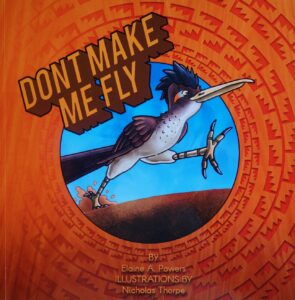Did you know that people sometimes call lizards toads? Toads—which are amphibians, by the way, not reptiles like us lizards. Even this lizard’s scientific name refers to toads! Phrynosoma means “toad-bodied”–all because they have flat, round bodies and blunt snouts. The correct common name for these interesting lizards is Horned Lizard—not horny toad!
The Horned Lizard doesn’t move around much, allowing its camouflage to help protect it from predators. The spines on the Horned Lizard’s back are modified scales, but they still make the lizard hard to swallow, especially when it puffs up. Roadrunners have learned to swallow the lizard with the spines facing away from them, so they don’t puncture their innards. That is an interesting fact from the rhyming and fun science book, Don’t Make Me Fly!, by Elaine A. Powers.

Arizona Daily Star:
What a curious creature the Roadrunner is! This iconic desert bird prefers hoofing it to flying, and its footprints are the same backward as they are forward. With vibrant illustrations by Nicholas Thorpe, this picture book is jam-packed with scientific facts about roadrunners, delivered in verse form to keep the narrative lively. Roadrunners
“grab their victim
behind its head
And bash it on
the ground until it’s dead.”
Want to know how to swallow a horned lizard? Keep reading! Don’t Make Me Fly! is recommended for children in grades K-4.
The horns on the lizard, however, are true horns, since they have a bony core. The lizard in the above photo is a Regal Horned Lizard, Phrynosoma solare. It gets its common name from the row of horns on its head. Regal Horned Lizards eat harvester ants, lots of harvester ants, over two thousand per meal. And they eat during the incredibly hot days in the desert!
Along with camouflage, spines, and running, Horned Lizards can also squirt blood from their eyes. (Ewwww, right?) The bad-tasting blood hits the predator’s mouth, discouraging it from eating the lizard. Now, that’s one trait I wouldn’t mind having. “Come on down, seagull! Open wide!”
So, dear readers, when you see any of these wonderful, interesting lizards, please don’t call them horny toads! Remember they are the amazing Horned LIZARDS–reptiles. Just like me, of course!
